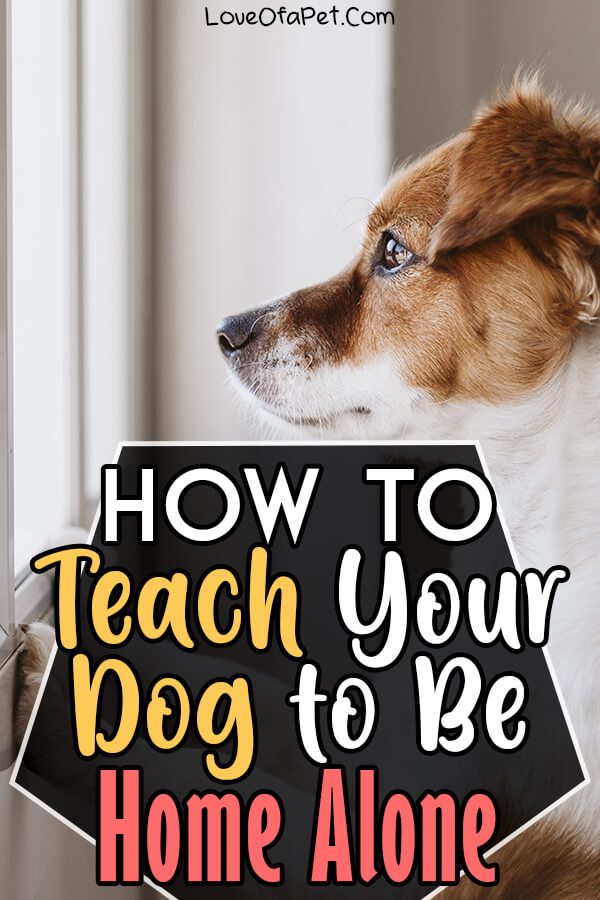“MY dog is chasing me wherever I go inside the house when I’m preparing to go outside.” “My puppy keeps on whining when he senses that I will leave home and this makes my heart melt wanting me to stay.” “My dog barks so much and always jumping on me, it is like my dog is telling me that he wants to come with me or wanting me to be with him.” And the sad reality is that you are not or may not be able to stay at your home with your dog 24/7, probably because of work or any other commitments.
In such cases, frustrated pet owners are asking,” What can I do?”
Dogs are instinctively social animals. And dogs are intelligent. Some dogs have been trained to sniff out drugs or explosives, assist and perform in search-and-rescue missions. Also, they can adapt to their environment.
But how can you teach your dog to be home alone?
Here are some useful steps that will help you train your dog to stay home alone.
Contents
7 Steps for Teaching Your Dog to Stay Home Alone
1. Train Your Dog or Puppy to Be Home Alone for Short Periods
You need to start little by little, as early while your dog is still a puppy (if you got/adopt a puppy) if possible. Your aim at first is to build up to it.
You can start by leaving your dog home alone at short intervals. You need to start slow. You can go outside for 30 minutes, go to the grocery or just go outside and leave him alone. You can increase the time of leaving your dog home alone as soon as your dog gets used to it.
Tip: Keep training sessions short and pleasurable.
2. Exercise Your Dog/puppy Before Leaving
Take time from where you can walk your pet daily. Dogs are energetic. You have to unleash this energy to make them calm. It is useful for them and for you to tire them out that would eventually make them go to sleep.
Take your dogs outdoor for 30 minutes to an hour to take out the energy. This will help your dog’s physical and mental stimulation.
Tip: Don’t let them stay out under the sun for a long period, our goal is to exercise them not to make them heat.
3. Create a Secure Dog/Puppy Zone
Train your puppy to stay in a crate*. Crates are a necessity for dogs or puppies to settle in an environment and this will train them to behave in a certain place.
Crates depend on the size of your puppy/dog and on the size of your place as well. Make a crate just enough for him for the first time, then making it bigger soon as he gets used to it and soon as your dog gets bigger.
Crates are a safe place, it should be pleasant and inviting. Make your dog comfortable with its crate. Put some yummy foods for your dog to chew in its crate. You can also put toys to make him busy inside the crate, a kong* toy is a good one.
Don’t leave them in a crate for a long period of time in their first time, it could cause isolation distress to them. And do not make them feel that crates are a punishment area. You can leave the crate open for the first time and allow your dog to go in and out of it and make them feel that that is their place until it gets used to it.
Tip: Give your dog attention and affection and praise them when it is in its crate. This will help your puppy/dog feel that the crate is its comfort zone wanting to be there most of the time.
4. Avoid Making a Fuss When Leaving and Coming Home
Stop making it a big deal when leaving. Stop saying emotional goodbyes when leaving, this will make your dog feel anxious and might have separation anxieties. Keep it positive, simply say “ Bye buddy, See you later” something like simple positive goodbyes. You have to resist the urge!
Don’t make a fuss when you arrived either. Don’t create bad behaviors. Your dog is already excited to see you, don’t fire the heat, to avoid creating bad habits for your dog. You have to ignore them at a moment. Walk directly to the fridge or do whatever you need to do. Wait for your dog to be calm and then you can start cuddling or playing with your dog or puppy.
Your dog must understand that your departure and arrival is something casual and usual.
Tip: Reward your dog after being calm. Liberal praises are good as a reward too.
5. Turn Up the Tunes
Study shows that music can reduce your dog’s anxieties and misbehaving behaviors such as chewing, barking and scratching.
Your puppy can more likely to relax with reggae music, soft rock, and slow classical music. You can also turn on the tv with animal shows.
Tip: Avoid any loud noise this could make your dog agitated and stressed.
6. Pay Attention to Your Dog Needs Before You Leave
A few things to keep in mind before leaving, make sure you leave them with fresh water to keep them hydrated. Your puppies and dogs must be well-fed. Your dog wouldn’t mind the odds if he knows that he’s getting fed up even if he’s alone.
Tip: Do not leave any food somewhere that within the reach of your dog. Make sure that he only gets what he needs. Ensure his food and water in a secure place and container.
7. Train Your Dog to Obey Simple Commands
Teaching your dog to obey basic commands can help you more on teaching your dog to be home alone a bit easier. While still a puppy or an old dog, they can still learn to obey.
To do this, first, you have to learn the genetic makeup of your dog.
And then start teaching by simple one-word command then, demonstrate actions, and then after every job well done, give your dog a reward or praises.
Tips: you should be consistent in your use of words when commanding. Always use your dog’s name when commanding. And do not forget to give them treats or rewards when they obey your commands.
These are some useful and effective steps to teach your dog to be home alone. Of course, as the owner of a dog, you might need some pieces of training too, or some traits you must possess.
Be Calm and Patient
Train your dog and train yourself as well to be calm. Teaching a dog to be home alone needs time and effort. The big part of success lies in you as their trainer/owner. Routines are the backbones of training!
Be patience, just keep following these steps until your dog gets used to it. Eventually, sooner or later you’ll both enjoy these routines and it will surely reduce the stress for both of you when leaving your dog home alone.
*Additional Info:
What Is a Dog Crate?
A dog crate can be usually plastic or a collapsible metal-enclosed pen for dogs. Crate varies on sizes and styles. Crates are used for dog behavior training. Having a crate when leaving your place and no one is around to supervise your dog is a good decision to make. You can buy them at a pet store.
What Is a Kong Toy?
A kong toy is a rubber-made toy for dogs. It is a toy at the same time a food container. It can be a good toy to make your dog busy especially when they are alone. It varies in sizes too. You can buy them online or at a pet store.
What Are Separation Anxieties in Dogs and How Can You Help?
Separations anxiety can both be stressful to dogs and the pet owner. Dogs get anxious when they are being left alone. Separation anxieties occur in any kind of dog. Dogs do not necessarily have the nature to be alone, but the good thing is they can adapt.
There’s a lot of reasons that dogs can have separation anxiety. But what can you do to help? It is a long process and it requires patience. You need to keep their minds occupied. You can feed them food and based on some studies, some music can help dogs become calm, some need requires medication. If you think your dog is in a serious state that you cant get them calm, then you need to seek help from a trainer or veterinary.
A Delightful Companion
Keep in mind that dogs are social animals. Long durations of confinement can lead your dog to hyperactivity, separation anxieties, destructive behaviors such as excessive barking, whining, crying, etc. But with training, your dog can learn to enjoy being home alone without making any disturbances and become a delightful companion- instead of being a nuisance.






Excellent advice